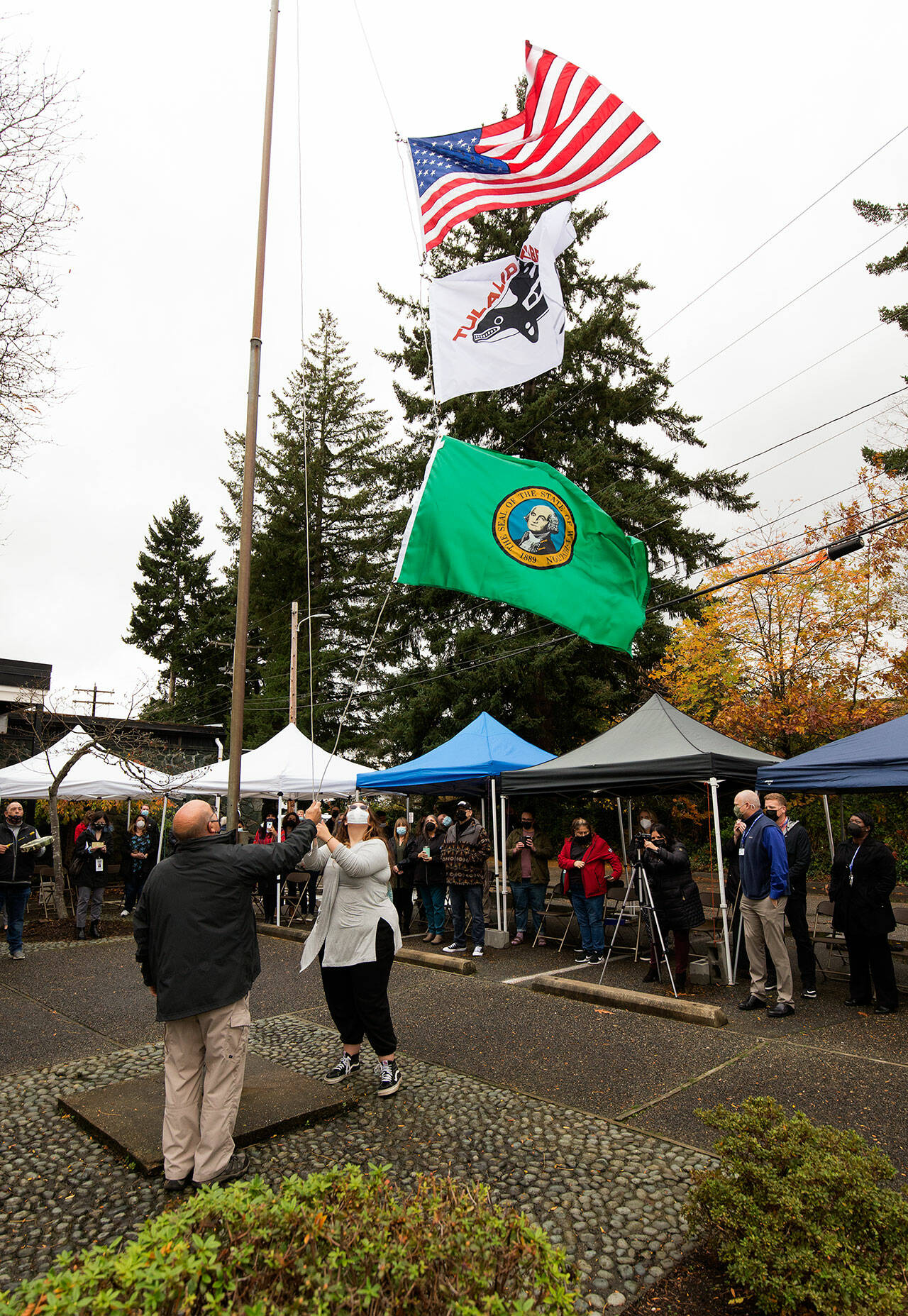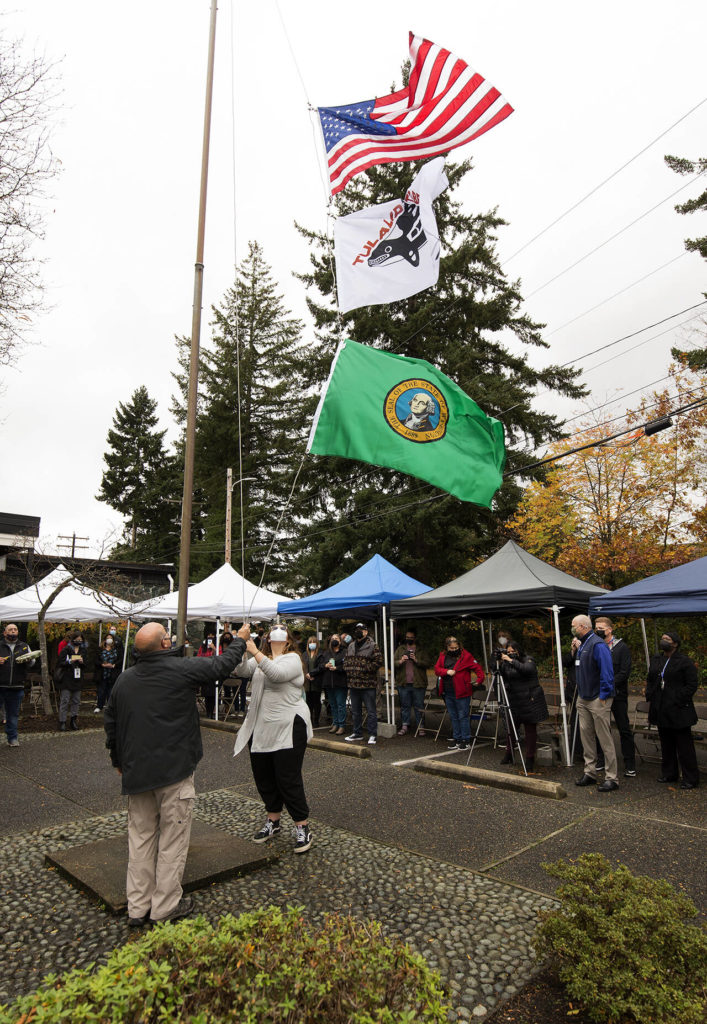MARYSVILLE — The day after school board directors adopted a new educational equity policy, high school student Tony Hatch raised the Tulalip Tribes’ killer whale flag above the school district’s buildings on 80th Street NE.
“It felt really good,” said Hatch, a senior at Marysville Pilchuck High School, on Thursday. “I felt like I was helping my people. Knowing that we have a piece of our side on this side (of the freeway) is really good and really fills my heart.”
Soon, the flag will fly at every Marysville school campus — and two schools have narrowed down mascots that will replace Native American symbols.
Outgoing school board directors shared their hopes for the district’s future Wednesday.
“I do challenge the next board that you hold everybody accountable,” Marysville school board President Vanessa Edwards said, speaking of the equity policy. “Outlined on here, from the top to the bottom, all of us are accountable to make sure that we provide what we say we will to all of our students.”
The new equity policy comes after a year mired in controversy, when two separate threats surfaced, directed toward students of color in Marysville schools. For months, both the community and educators made pleas for Marysville School District administrators to act.
The seven-page policy outlines a pledge to recruit and support a diverse workforce, use culturally responsive instructional methods and connect students to social-emotional and extra-curricular opportunities that strengthen inclusivity.
The board will be required to review the policy annually and measure success through graduation and discipline rates, academic achievement and social climate surveys. It was a collaborative effort by district officials, students, educators and families, as well as members of the greater community.
Eneille Nelson, executive director of equity and family engagement for the district, said three equity advisory teams — a student team, a parent and community team, and a district staff team — gave input and agreed on the policy’s language.
“We used our personal experiences in the district as students to help guide us (to) make the most well-rounded policy that we could,” said Evelyn Vega-Simpson, officer on the Tulalip Youth council. “We hope that we have helped students of color feel more safe, welcome and respected.”
Kaiser Moses, chairman of the senior Youth Council, echoed Vega-Simpson’s sentiment.
“What I’m really happy to see here is that the school board here is taking an interest in the health of the kids,” he said. “And that what we’re doing here will help the kids of not just this year or next year but also future years.”
The policy aims to ensure students of all backgrounds have an equal shot at success in the district, Edwards said. This begins with representation. Next, the district is looking to add a permanent voice from the Tulalip Tribes to their decision-making process.
The last tribal member to serve on the school board was Don Hatch. Ray Sheldon Jr. made a run for the seat this year but fell a few hundred votes short.
“When I was on the board, I wanted to make sure all the kids and all the parents had a fair shake,” Hatch said. “It’s not fair right now.”
District officials say they’re working to fix that.
Interim Superintendent Chris Pearson said the tribes and district have had some informal meetings, but he’s hoping to add a permanent policy that will ensure this practice continues, even under new leadership.
“Their voice is needed because they are a very, very important part of our school district,” Nelson said.
If the board adopts the policy, an ambassador to the Tulalip Tribes will serve as a professional advisor to the Marysville school board and district leadership. The ambassador will have up to 20 minutes at each school board meeting to discuss any issues, information or concerns related to The Tulalip Tribes students and families.
The ambassador will be appointed by the Tulalip Tribes Board of Directors.
In exchange, the superintendent will serve as a school district ambassador to the Tulalip Tribes. He will have up to 30 minutes at one of the tribes’ Board of Directors meetings each month to provide district updates relevant to Indigenous students and families.
New mascots unveiled
By the end of this year, Marysville Pilchuck High School will say goodbye to its long-controversial mascot, the Tomahawks. Likewise, the Totem Middle School Thunderbirds will be no more.
According to Tulalip tribal member Dr. Stephanie Fryberg’s late 2000s research, “exposure to American Indian mascot images has a negative impact on American Indian high school and college students’ feelings of personal and community worth.”
On Wednesday, Totem Middle and Marysville Pilchuck High School principals Keri Lindsay and Brian Tinsley announced students, staff and community members narrowed lengthy lists of possible mascots to three finalists at each school.
The Totem Thunderbirds could be known as the Totem Phoenixes, Titans or Kodiaks.
The MP community is eyeing the Mountaineers, Titans or Ravens for their new mascot.
A steering committee and a mascot committee were formed at each school, composed of students, family, staff and other locals.
“We started this work and wanted to make sure that we got lots of community input and input from our current students and former students — it was really important that everybody got a voice,” Lindsay said. Tulalip elders were invited to share their thoughts during in-person meetings and students gave input through online surveys, she said.
The process began late this summer, led by educational equity consultants Mary Fertakis and J. Marie Riche. The committees met every Monday to discuss ideas and goals.
Over the next week, Totem students and families can weigh in on the final three options through an online survey. The final choice will come before the school board Nov. 15 for approval.
At MP, student focus groups will evaluate the three finalists in the coming weeks and bring their recommendation to the school board Nov. 22.
By January, both schools will have a new mascot, and the image of the new mascot will be unveiled by the end of the school year.
The tribes requested the changes under a new state law giving tribes the option to veto mascots they deem “inappropriate,” if they belong to schools with enrollment boundaries on tribal reservation or trust lands.
“All the work that’s been done behind that it just was making making my heart feel very happy,” said Gina Bluebird, a resiliency interventionist at Quil Ceda Elementary. “That level of recognition and the willingness to make those changes I know that’s hard, it’s difficult, but it just really shows that our district is moving towards that equity and really looking at how we can support all of our nations within our district.”
Isabella Breda: 425-339-3192; isabella.breda@heraldnet.com. Twitter: @BredaIsabella.
Talk to us
> Give us your news tips.
> Send us a letter to the editor.
> More Herald contact information.


























